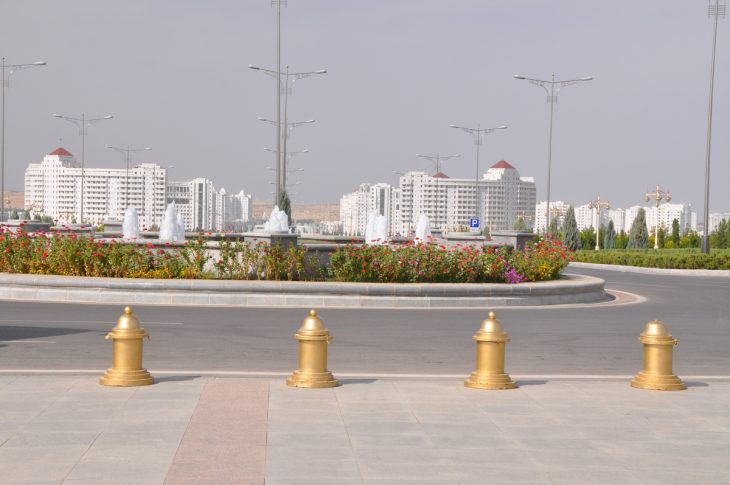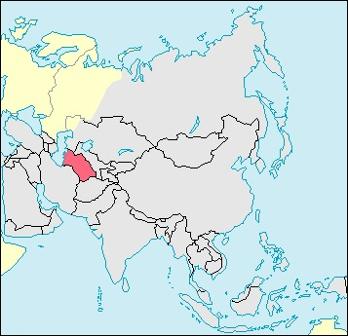What is the Capital of Turkmenistan? Ashgabat

Capital City of Turkmenistan: Ashgabat
City Overview
Ashgabat is the capital and largest city of Turkmenistan, a country located in Central Asia, bordered by Kazakhstan, Uzbekistan, Afghanistan, and the Caspian Sea. Known for its striking white marble buildings and wide boulevards, Ashgabat is one of the most visually distinct capital cities in the world. The city’s unique architecture, alongside its modern infrastructure, has earned Ashgabat a reputation for opulence, often seen as a reflection of the country’s wealth, largely derived from its vast reserves of natural gas.
Ashgabat serves as Turkmenistan’s political, cultural, and economic center. It houses the Presidential Palace, government ministries, and the National Museum of Turkmenistan. The city is home to a number of international embassies and serves as the country’s diplomatic hub. While Ashgabat has undergone rapid urban development since Turkmenistan’s independence from the Soviet Union in 1991, it still retains elements of its traditional Central Asian heritage, with vibrant bazaars, museums, and monuments reflecting the rich cultural history of Turkmenistan.
The city is located in the Kopet Dag mountain range, with a desert climate that is characteristic of much of the region. Ashgabat has seen impressive growth and modernization in recent decades, including infrastructure projects like highways, public transportation, and recreational spaces. However, this development has come with challenges such as high living costs, economic dependence on energy exports, and limited political freedoms.
Ashgabat plays a crucial role in the country’s energy economy, with Turkmenistan possessing some of the largest natural gas reserves in the world. The city is the main administrative center for the country’s state-owned oil and gas companies, and its international relations often revolve around energy trade, particularly with neighboring countries like China, Russia, and Iran.
Key Facts:
- Area: 1,100 km² (Ashgabat city)
- Population: Approximately 1 million (2023 estimate)
- Time Zone: Turkmenistan Time (TMT), UTC +5
- Highest Mountain: Mount Ayrybaba, 3,138 meters (Kopet Dag mountains)
- Longest River: Amu Darya River, which flows from the Tian Shan Mountains to the Aral Sea.
The city’s economy is heavily dependent on gas exports, which form the backbone of Turkmenistan’s GDP. Ashgabat is also a center for trade, business, and education, hosting universities like the Turkmen State University and the International University for Humanities and Development. In addition to its political and economic functions, the city also serves as a hub for culture, with theaters, music festivals, and exhibitions celebrating Turkmen traditions.
Major Landmarks in Ashgabat
Ashgabat is known for its impressive landmarks, many of which reflect Turkmenistan’s national pride and the desire to project modernity and wealth. The city boasts a mix of post-Soviet and neo-classical styles, with white marble dominating its skyline. Here are some of the most iconic landmarks in the capital:
1. The Arch of Neutrality
One of Ashgabat’s most famous landmarks is the Arch of Neutrality, a towering monument that symbolizes Turkmenistan’s policy of neutrality in international affairs. Standing 95 meters tall, the arch features a golden statue of Saparmurat Niyazov, the first President of Turkmenistan, who is shown holding a book. The arch is a symbol of the nation’s independence and is a key tourist attraction.
2. Independence Monument
The Independence Monument, which stands in the center of Ashgabat, celebrates Turkmenistan’s independence from the Soviet Union in 1991. The monument consists of a tall column topped with a golden statue of Independence, surrounded by statues of the country’s historical figures and symbols of Turkmen culture. This landmark represents the nation’s journey toward sovereignty and is an important symbol of national pride.
3. Turkmenistan National Museum
The National Museum of Turkmenistan is an important cultural institution in Ashgabat. It showcases the rich history and heritage of Turkmenistan, featuring exhibits on archaeology, ethnography, and art. The museum’s modern design contrasts with its ancient collections, which include artifacts from the Bronze Age, Sassanid Empire, and Seljuk Turks. Visitors can learn about the country’s Turkmen carpet weaving, history of the Silk Road, and national traditions.
4. The Bagt Koshgi Palace
This palace, located in the outskirts of Ashgabat, is one of the largest in the world. It is used for ceremonial purposes and state functions and is an imposing symbol of the wealth and political stature of Turkmenistan. The palace’s architecture is lavish, with expansive grounds and ornate interiors.
5. The Neutrality Monument
The Neutrality Monument is another significant landmark in Ashgabat, dedicated to Turkmenistan’s foreign policy of permanent neutrality. It’s a striking white marble structure that symbolizes the country’s commitment to peaceful international relations. The monument was erected in honor of Turkmenistan’s permanent neutrality status granted by the United Nations in 1995.
6. Ruhyet Palace
The Ruhyet Palace, located in the southern part of Ashgabat, is a stunning cultural and performance venue. It is used for various events, including concerts, conferences, and ceremonies. The palace’s grand architecture and interior design reflect the nation’s dedication to preserving its cultural identity while embracing modernity.
Climate Overview
Ashgabat experiences a hot desert climate, typical of Central Asia, characterized by hot summers and mild winters. Due to its location near the Kopet Dag mountains, it is affected by the harsh winds of the Karakum Desert. Winters are generally dry and cool, while summers are extremely hot, with temperatures regularly exceeding 40°C in July and August.
The city receives very little annual rainfall, making it one of the driest places in the world. However, temperatures remain relatively stable throughout the year, and precipitation is concentrated in the winter and early spring months.
Monthly Average Climate Data (Ashgabat):
| Month | Average Temperature (°C) | Precipitation (mm) | Sunny Days |
|---|---|---|---|
| January | 3°C | 8 mm | 9 |
| February | 5°C | 9 mm | 10 |
| March | 11°C | 13 mm | 10 |
| April | 16°C | 17 mm | 12 |
| May | 22°C | 3 mm | 14 |
| June | 30°C | 1 mm | 14 |
| July | 35°C | 0 mm | 15 |
| August | 34°C | 0 mm | 15 |
| September | 26°C | 7 mm | 14 |
| October | 17°C | 16 mm | 13 |
| November | 9°C | 12 mm | 11 |
| December | 4°C | 10 mm | 9 |
Other Cities as Capital in Turkmenistan’s History
Ashgabat has been the capital of Turkmenistan since its founding as a Russian military outpost in 1881. However, there have been other key cities and locations in Turkmenistan’s history:
1. Merv (before Ashgabat, Ancient Times)
Before Ashgabat became the capital, Merv was an important city in Turkmenistan, historically serving as a major city on the Silk Road. In ancient times, Merv was the center of the Sassanian Empire and later part of the Abbasid Caliphate. Today, it is an archaeological site, known for its historical ruins.
2. Ashgabat (Post-Soviet Era)
After Turkmenistan’s independence in 1991, Ashgabat was reaffirmed as the capital of the newly independent republic. The city underwent massive urban development during the presidency of Saparmurat Niyazov, and continues to be a symbol of Turkmenistan’s modern era.
Country Facts
Turkmenistan is one of the most sparsely populated countries in the world, with vast stretches of desert landscape dominating much of the country. It is rich in natural gas and oil, which provide the foundation of its economy.
Key Country Facts:
- Population: Approximately 6.3 million (2023 estimate)
- Area: 491,210 km²
- Largest City: Ashgabat
- Currency: Turkmenistani Manat (TMT)
- Official Language: Turkmen
- ISO Country Codes: TM (Alpha-2), TKM (Alpha-3)
- Major Religion: Sunni Islam
- Government: Authoritarian Presidential Republic
- Independence: October 27, 1991 (from the Soviet Union)
Turkmenistan remains one of the most isolated countries in Central Asia, with a closed economy and strict government controls over public life. Despite its wealth in natural resources, much of the population still faces challenges such as limited access to free information, high levels of poverty, and restrictions on personal freedoms.














































